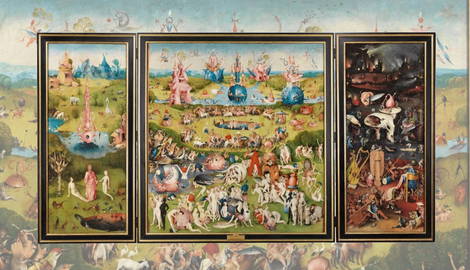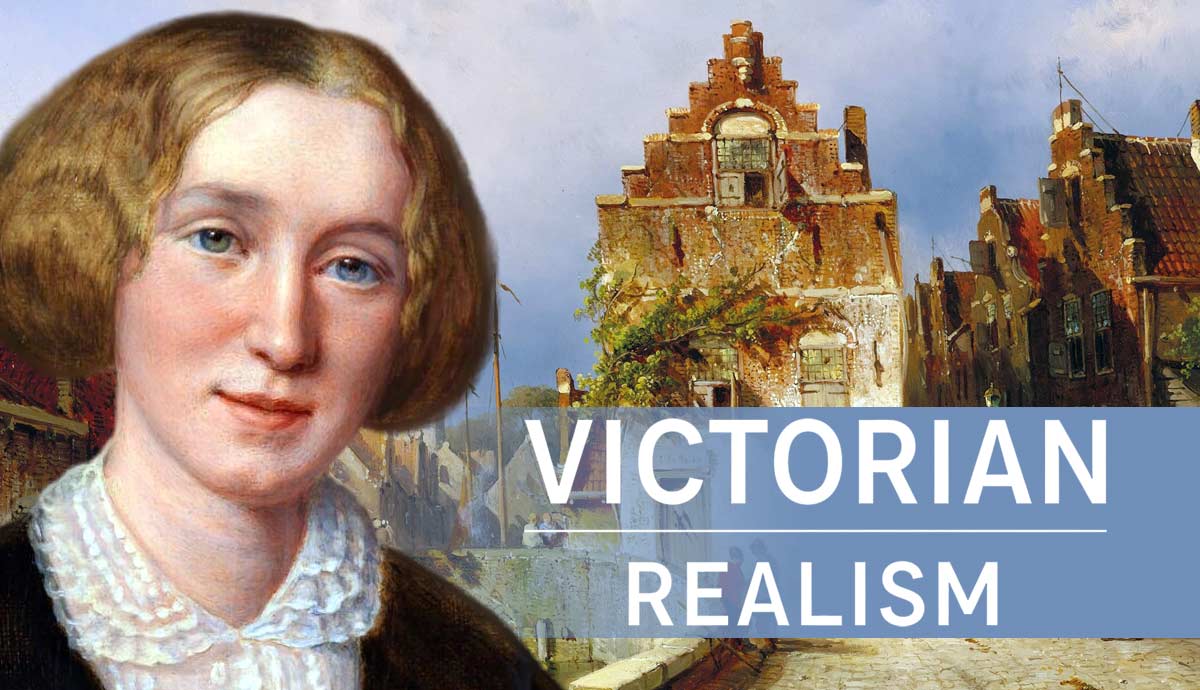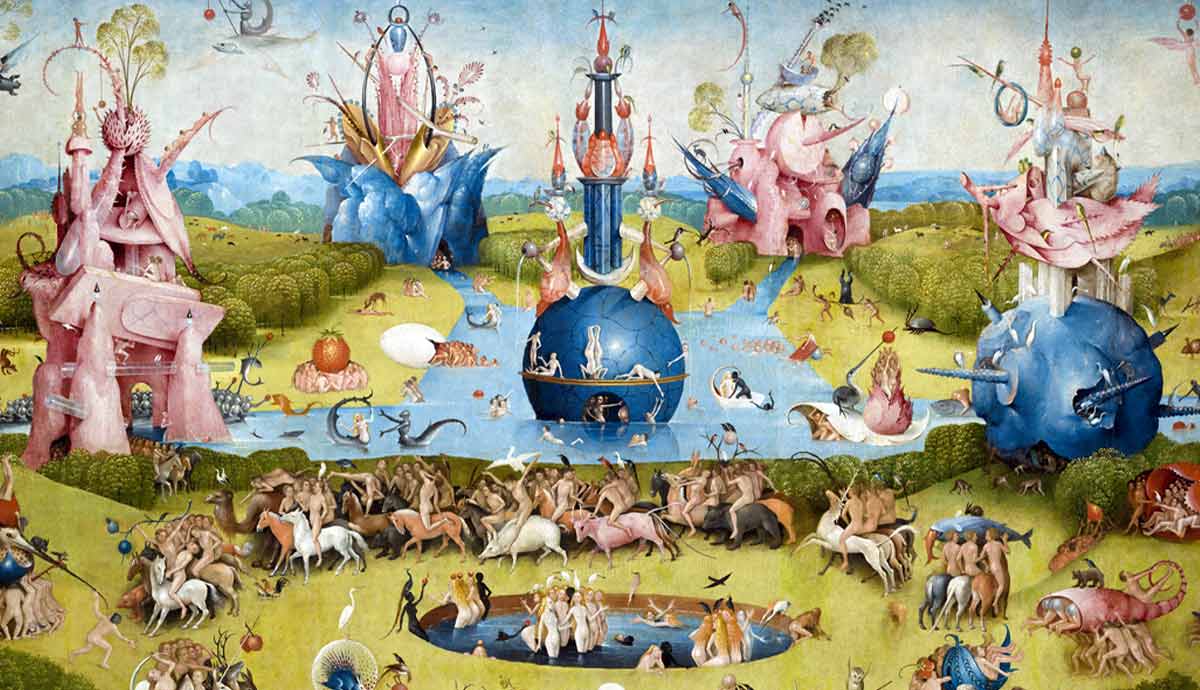
The Garden of Earthly Delights is a triptych painted by the master Hieronymus Bosch (c.1450-1516) — an Early Netherlandish painter. It has been housed in Madrid’s Museo Del Prado since 1939. Dating between 1490 and 1510, when Bosch was about 40 (or 50) years old, it is one of his best known and most ambitious works.
Bosch’s Garden of Earthly Delights depicts Paradise, with Adam and Eve, the earthly delights, numerous nude figures, and Hell, with depictions of the fantastic punishments of various types of sinners. On the exterior panel, the viewer can only see God creating the Earth. The Garden of Earthly Delights is a story about morals and sin. Here are 10 facts you need to know about this masterpiece.
1. The Size Of The Garden Of Earthly Delights Triptych

It’s huge! The height is 205.5cm (81 inches), and the width is 384.9cm (152 inches). The width of each wing is 76.5cm (30 inches). The central panel is 231.9cm (91 inches), and in its closed form, the exterior diptych is 153cm (60 inches). This unique oversized triptych piece is almost 4 meters wide (13.12 ft) and 2 meters high (6.56 ft), and includes hundreds of nude figures, mysterious creatures and machines, strange animals, and fruits.
Bosch’s Garden of Earthly Delights is the largest of Bosch’s most famous surviving triptychs, which include: The Last Judgment, HayWain, Epiphany (Adoration of the magi), and Temptations of Saint Anthony.
The Garden of Earthly Delights‘ exterior was conceived as a roundel, with the sphere of the cosmos (Earth) forming a circle that extends across the two shutters. Bosch’s use of the roundel format only on the outside of his triptychs established the area’s exterior. He deliberately emphasized universal content and related it directly to the viewer. The change from the vast scale (exterior) to the miniaturized scale (interior) creates a transition from the macrocosm to the microcosm. The more monumental scale of the exterior gives the closed view of this altarpiece an extraordinary visual presence.
Throughout all the panels, the scale is vital. These are all large panels, but the figures are relatively small. Bosch’s sustained creativity is astonishing; he created a painting with hundreds of figures, each of which is entertaining, curious, and bizarre.
Click here, for a more detailed discussion of the painting’s scale, by art historian Reindert Falkenburg.
2. Color Τechnique: Grisaille Vs Vivid Colors

The triptych is painted in oil, on oak wood panels and consists of a middle panel flanked by two rectangular wings that can close over the center as shutters. These wings display a grisaille painting of the earth during the creation. Grisaille is a painting technique which uses a monochromatic palette of greys, and the etymologically of the word comes from the French “gris” [grey].
Bosch commonly used grisaille on his exteriors, but he also achieved coloristic effects. The exterior of the Garden of Earthly Delights includes highlights of pale pink and creamy white. The coloristic effect of Bosch’s grisaille is enhanced by his loose, painterly brushstrokes, which create shimmering highlights that give the images energy and life.

For the interior panels, Bosch’s palette is exceptionally vivid and includes a variety of pigments such as yellow [yellow ochre, lead-tin yellow], blue [azurite], red [vermillion, carmine lake], green[malachite, copper resinate], white [lead white], and black [ivory black] — a late Gothic palette.
While his work is now recognized as Late Gothic, technically, Bosch painted in a style known as “Alla prima,” a painting technique in which pigments are applied wet on wet without letting earlier layers dry. The pigments are laid on in one application with little or no underpainting. In Italian, the term “Alla prima” means “at first attempt.”
3. Dating Of Bosch’s Garden Of Earthly Delights

Although the Garden of the Earthly Delights is not signed, its attribution to Bosch has never been doubted. Its date, however, is a subject of considerable debate. Based on Museo del Prado’s report, the dendrochronological analysis (tree-ring study) seems to locate it within the early years of the artist’s activity, around 1480-85.
However, the work’s stylistic similarity to Adoration of the Magi triptych —which can be securely dated to 1494 —confirms that the work must have been painted in the 1490s and not after 1505.
4. The Origin Of The Title And Function Of The Painting

One of the earliest surviving descriptions of Bosch’s Garden of the Earthly Delights appears in the Historia de la Orden de San Geronimo, written by Fray Jose Sigüenza in 1605. By this time, the triptych had been in Spain for some years and was placed in the Escorial monastery.
Jose Sigüenza called the work the “Strawberry Plant,” probably because this fruit is represented several times in the panel. Bosch’s picture, he explained, is “of the vanity and glory and transient taste of strawberries or the fruit of the strawberry plant and its fragrance, which one can hardly smell when it passes.”
Later, in 1947, Wilhelm Fraenger proposed a new theory and name, the well-known Garden of Earthly Delights, because he refused to see the central panel as a picture of humankind wallowing in sensual pleasure. The term “Garden of the Earthly Delights” is also the modern title of the triptych.

The Garden of Earthly Delights has significant secular content. Whether it is understood as a scene of sin, or as man’s paradisiacal state before the Fall, the center focuses on earthly pleasures. There is strong reason to believe that Bosch’s Garden of Earthly Delights was intended for a secular rather than ecclesiastical location.
Art Historian, Ernst H. Gombrich, discussed the earliest description of Bosch’s Garden of Delight in 1967, and he linked the painting with the Nassau family. Antonio de Beatis (secretary of Cardinal Luigi of Aragon) in his Travel Journal indicated that on 30 July 1517, the triptych was in the Nassau palace of Coudenberg in Brussels.
“…then there are some panel paintings of various bizarre themes where seas, skies, woods, the countryside are simulated, together with figures who emerge from a mussel shell, others who defecate cranes; and men and women, white and black, with different postures and expressions, birds, animals of all kinds rendered with great naturalness, things so pleasing and so fantastic that they could not be properly described in any way to those who do not know them”. Antonio de Beatis, 30 July 1517

Since the late 1960s, this painting was considered a late work by Bosch, executed after Engelbrecht II of Nassau’s death in 1504. It was thought that the patron was Henry III of Nassau, Engelbrecht’s nephew and heir. In the present day, it can be confirmed that it was commissioned from Bosch by Engelbrecht II, who must have intended it for the Coudenberg Palace. Although we have no information about the original function of the painting, its subject matter suggests that it would not have decorated an altar in a church…
Because the triptych was publicly displayed in the palace of Nassau, Bosch’s reputation and fame quickly spread across Europe. There are numerous surviving copies commissioned by wealthy patrons. These copies were usually painted on a much smaller scale and they vary considerably in quality. Many were created a generation after Bosch, and some took the form of wall tapestries.
5. Read It Like A Book

Many art historians believe that the triptych is meant to be read from left to right, which tells the story of Eve’s creation, humanity’s Fall, and their eventual way to Hell as a punishment. There are several conflicting interpretations of the center panel. Some believe it depicts a sinful explosion, while others think it represents humanity’s innocence before the Fall.
Whichever is correct, Bosch is giving his audience a message and something to contemplate. Each part of the triptych can be seen as its own story, viewed as a whole, or broken down into smaller stories.
6. Symbolism And Meaning: Pink And Blue

One of the simplest ways to look at this painting is through Bosch’s use of color. Bosch used color to significant effect. Specific colors have particular meanings that are repeated and are consistent throughout the triptych. The critical colors are: pink, blue, ochre, lime, white, and red.
Pink represents divinity and the influence of the divine, fecundity, generative power, and inner quality. It is used for the robe of God, which is the key that indicates the color’s meaning. In the right panel, the color is used to indicate figures under an illusion of divinity or posing as divine authority.
Blue represents the Earth, earthly influences, and the material manifestation of the universe. It is first used in the earthly mountains on the right, in the left-hand panel. The color always represents a lower-level. In the right panel, the color is used to indicate figures under the influence of lower forces.
Ochre and Lime

Ochre represents the mind, intelligence, awareness, and consciousness. First, it is used in the transcendent divine mountain, then in the head of the man in the left panel, showing corrupted thoughts flowing into it. As the color grows darker, it represents lower influences.
Lime represents the ideal or overall best that can be achieved under a set of circumstances. It floods the entire ground of the left panel because the Earth is under divine influence and hasn’t been transformed yet. In the right panel, the color is used to indicate the best that can be achieved under the adverse circumstances that predominate in the painting.
White And Red

White represents purity and holiness. It is first introduced in the white of the unicorn in Eden. In the right panel, the color is used to indicate figures that appear holy but are cloaked in falsehood. It also indicates lies when used in pearls in the right panel.

Red symbolizes lust or passion, temptation, and sexuality, both in its earthly and heavenly procreative form. Lastly, it is used for the cherries, as spiritual temptations and for the strawberries, as lust.
Fruit

The fruit comes in many guises. Almost all of them represent temptation or lust in one form or another. The color is an indicator: red cherries are spiritual temptations; blue or blackberries are earthly temptations. The center panel is flooded with fruit images, representing the ubiquity of temptation once the divine intersects with worldly influences.

The center –inner- panel of the painting includes a series of motifs.
Nude men and women, fair and dark-skinned, together with various animals, plants, and fruits, portray their sexuality openly and without judgment or shame. Viewers are still deciphering the vivid imagery in the expansive garden landscape and continue to be divided on the symbolism, which has led to a wide range of interpretations through the centuries.
The art historian Hans Belting, for example, argues that what we see in the center panel is a utopian world, where sexuality is not admonished, an offer of an alternative vision to the biblical Garden of Eden.
According to Laurinda Dixon, the numerous nude figures suggest “a certain adolescent sexual curiosity.” Could Bosch’s colors and depiction of humans — whether cavorting with fantastical animals, feasting on enlarged fruits, or engaging in foreplay — be neither a didactic warning on the sinfulness of sexuality nor a depiction of paradise lost? Less a representation of vice, the Garden of Earthly Delights is perhaps a commentary on humanity’s connection to nature and fundamental ephemerality.
For further exploration of these themes, by Professor Pilar Silva, click here.
7. Hidden Μusic

The large musical instruments represent the justice system created by man and how it is corrupt and a subject to our imagination; in no way reflecting divine justice. Demons balancing books on their heads represent attorneys. The judge (clothed in pink because he thinks he is God) composes the law with his tongue (a string of white pearls) on the butt of a defendant.
This music has been transcribed by Amelia Hamrick, an Oklahoma Christian University student. Since posting the track online on tumblr.com, Hamrick’s composition has gone viral, you can listen to it here.
Or check out an adapted version of the melody “Butt Music” by Jim Spalink, here.
8. Is There A Self-Portrait Of The Painter In The Hell Panel?

The “tree-man” is the focal point of Hell in the right panel and he is formed from a broken eggshell. This eggshell-like torso appears to be supported by tree trunks which are at odds with the fragile body. Inside the body there is a hellish tavern scene, while the head supports a large disc filled with devils and their victims.

Hans Belting wondered if the tree-man’s face is a self-portrait, citing the figure’s “expression of irony and the slightly sideways gaze [which would] then constitute the signature of an artist who claimed a bizarre pictorial world for his own personal imagination.” The meaning of this enigmatic figure has never been explained adequately, but nevertheless, Bosch has successfully created an image from a dream — or a nightmare.

The “Tree-man” from the Hell panel was also depicted in an earlier drawing by Bosch. This pen and bistre version contains no suggestion of hell, yet its outline was adopted as one of The Garden of Earthly Delights’ most memorable grotesques.
9. Bosch And The Surrealists

With the advent of modern art during the 20th century, people started to look at Bosch afresh. Charles de Mooij, the museum director of the Noordbrabants Museum in Den Bosch, stated that “the Surrealists believed that Bosch was the first modern artist.” Salvador Dali studied the works of Bosch and recognized him as his predecessor. “Like Bosch, Dali was a very realistic painter, whose creativity transformed things,” continues Charles de Mooij, who also points to the influence of Bosch upon other Surrealists such as Rene Magritte and Max Ernst.
“The Surrealists were changing normal things into abnormal things, just as Bosch did. Ultimately, though, they only took one part of Bosch: they didn’t take his [religious] message, but admired him for the strange, original forms that he created.”
It has even been suggested that the unusual rock formation resembling a face in Dali’s famous painting The Great Masturbator of 1929 was inspired by a similar shape visible in the landscape in the left panel of The Garden of Earthly Delights.
Paola Volkova, an art critic, and art historian, states: “When Andre Breton issued the Surrealist Manifesto in 1924, in the 20th Century, he first referred to Hieronymus Bosch as the predecessor of surrealism. That’s what it says; surrealism considers Hieronymus Bosch as its forerunner. Because his world turned inside out the consciousness, he reveals to us nightmares-phantoms of the subconscious, nightmares of the unconscious, presents us absolutely all the forms of our instincts, just embodied in images, in reality, in the subject, in allegory“.
10.The Online Interactive Documentary Of The Garden Of Earthly Delights

In 2016 the interactive documentary Jheronimus Bosch, The Garden of Earthly Delights coincided with the 500th anniversary of Hieronymus Bosch’s death, accompanied by the Noordbrabants Museum’s celebration in Hertogenbosch.
This interactive exhibit provides an in-depth tour through the painting, similar to a museum tour. The visitor is taken on an audio-visual journey through a web interface, which includes sound, music, video, and images to enrich the storytelling.
Bosch’s Garden of Earthly Delights is a story about morals and sin. But besides exploring the historical art of the painting, the visitor can better understand life in the Late Middle Ages.
What can you expect from this “interactive documentary”? It will let you explore the painting in incredible detail, down to the most minute brush strokes, and the audio tracks will move you through various sections of the painting, while a series of audio essays describe over 40 different areas of the masterpiece!
The interactive documentary Hieronymus Bosch’s The Garden of Earthly Delights, is part of the media triptych: ‘Hieronymus Bosch.’ The triptych consists of a documentary film ‘Hieronymus Bosch, Touched by the devil,’ as well as the documentary ‘Hieronymus Bosch: Garden of Earthly Delights‘, and the Virtual Reality tour ‘Hieronymus Bosch, the Eyes of the Owl.’
Visit the website http://jheronimus-bosch.nl for more.
The journey of each visitor is a personal one. Bosch’s Garden of Earthly Delights invites the visitor to reflect upon and question their sins and morals. A journey worth embarking on. Dare to take it!










